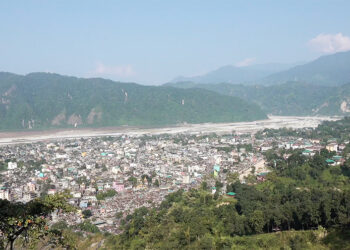 The heavy rain that caused flash floods nearly three weeks ago in Samtse’s Denchukha Gewog, not only washed away vital infrastructure but also shattered the livelihoods of many. With the gewog still cut off, residents are struggling to bring in essential supplies and take their produce to the market. This has left the entire community stranded and uncertain about what lies ahead.
The heavy rain that caused flash floods nearly three weeks ago in Samtse’s Denchukha Gewog, not only washed away vital infrastructure but also shattered the livelihoods of many. With the gewog still cut off, residents are struggling to bring in essential supplies and take their produce to the market. This has left the entire community stranded and uncertain about what lies ahead.
40-year-old Tshomidh Lepcha has been running her poultry farm for more than a decade. With over 300 hens, her small farm once brought her a steady income of around Nu 30,000 a month from selling eggs. But everything changed when disaster struck.
After multiple flash floods hit the gewog and the bailey suspension bridge over the Amochhu earlier this month, their only lifeline was washed away, and her family’s livelihood came to a standstill. What was once a bustling farm now struggles to survive. From collecting more than a carton of eggs a day, Tshomidh now gathers barely two trays. With limited access to poultry feed and dwindling supplies, her hens have stopped laying as before.
“I have been running in losses. There is feed shortage because we have cannot transport it. We once got the feeds delivered by helicopter but now it is running short. It is challenging for us to carry feeds on our back. Similarly, we cannot take the little amount of eggs that we have to market. There is no road and if we carry on our back, the eggs get broken.”
The challenge is the same for every poultry farm owner in the area. Limited feed and no connectivity have severely affected egg production, leaving most farms running at a loss.
Indra Bir Guung, a resident said, “The government helped us in bringing the feeds last time but now they are finishing. It would not last long if we rely only on the feeds, the stock would finish quickly so we are mixing the feeds with locally other grains such as maize.”
Similarly, piggery farmers are also struggling with a severe shortage of animal feed. As their supplies run low, many are anxious about how they will sustain their livelihoods. With no road connectivity, transporting feed has become both difficult and costly. Farmers now have to hire people to carry the heavy sacks from the last road point, the place where the bridge over the Amochhu was washed away.
Deo Kumar Limbu, a resident said, “We are having a tough time. The helicopter delivered the feeds last time that made us comfortable for about 20 days. Now, if road connectivity is not restored, we will have a tough time because we have to reserve an entire vehicle for ourselves from Dorokha till Amochhu and from there, people have to carry. The carrying charge per bag is over Nu 400. With these extra charges, the price of one bag of feed rises upto more than Nu 2600.”
Although helicopters delivered animal feed about two weeks ago, farmers are once again worried with the stock running out. The gewog remains cut off. Inside the gewog, most roads lie in ruins, many damaged beyond repair.
According to gewog officials, efforts are underway to clear and realign the Gewog Centre road hoping to make it at least partially usable. If successful, residents could transship goods across the temporary bamboo bridge.
However, the situation remains uncertain. Going by the time it took to build the old bridge, about five years, it could take years to construct a new motorable bridge. For now, people can only wait and hope for the day they can once again use their roads, resume their lives, and rebuild what the floods have taken away.
Kinley Dem, Samtse
Edited by Kipchu








